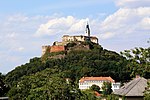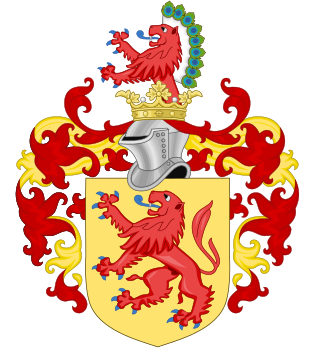
The House of Hapsburg, also known as the House of Austria, was one of the most prominent and important dynasties in European history.

Graz is the capital of the Austrian federal state of Styria and the second-largest city in Austria, after Vienna. As of 1 January 2024, Graz had a population of 303,270. In 2023, the population of the Graz larger urban zone (LUZ) stood at 660,238. Graz is known as a college and university city, with four colleges and four universities. Combined, the city is home to more than 60,000 students. Its historic centre (Altstadt) is one of the best-preserved city centres in Central Europe.
Duke of Burgundy was a title used by the rulers of the Duchy of Burgundy, from its establishment in 843 to its annexation by the French crown in 1477, and later by members of the House of Habsburg, including Holy Roman Emperors and kings of Spain, who claimed Burgundy proper and ruled the Burgundian Netherlands.

St Martin's Cathedral is a church in Bratislava, Slovakia, and the cathedral of the Archdiocese of Bratislava.
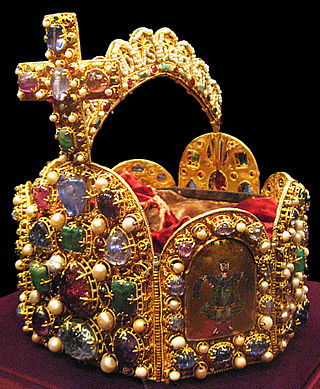
The Imperial Crown of the Holy Roman Empire, a hoop crown (Bügelkrone) with a characteristic octagonal shape, was the coronation crown of the Holy Roman Emperor, probably from the late 10th century until the dissolution of the Holy Roman Empire in 1806. The crown was used in the coronation of the King of the Romans, the title assumed by the Emperor-elect immediately after his election. It is now kept in the Imperial Treasury at the Hofburg in Vienna, Austria.

Nuremberg Castle is a group of medieval fortified buildings on a sandstone ridge dominating the historical center of Nuremberg in Bavaria, Germany.
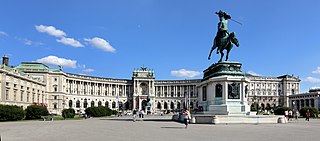
The Hofburg is the former principal imperial palace of the Habsburg dynasty in Austria. Located in the centre of Vienna, it was built in the 13th century and expanded several times afterwards. It also served as the imperial winter residence, as Schönbrunn Palace was the summer residence. Since 1946, it has been the official residence and workplace of the president of Austria.

Laxenburg is a market town in the district of Mödling, in the Austrian state of Lower Austria. Located about 20 km (12 mi) south of the Austrian capital Vienna, it is chiefly known for the Laxenburg castles, which, beside Schönbrunn, served as the most important summer retreat of the Habsburg monarchs.

Maria am Gestade is a Gothic church in Vienna, Austria. One of the oldest churches in the city—along with St. Peter's Church and St. Rupert's Church—it is one of the few surviving examples of Gothic architecture in Vienna. Located in the Innere Stadt at Salvatorgasse 12, near the Donaukanal, the church was traditionally used by sailors on the Danube river. The name reflects the former location on the Fluvial terrace of an arm of the Danube river, prior to its regulation.
Due to the stairs surrounding the church it got the popular name Maria Stiegen.

Schloss Hetzendorf is a baroque palace in Hetzendorf, Meidling, Vienna, that was used by the imperial Habsburg family.

Laxenburg castles are imperial palaces and castles outside Vienna, in the town of Laxenburg owned in equal parts by Vienna and Lower Austria. The castles became a Habsburg possession in 1333 and formerly served as a summer retreat, along with Schönbrunn palace, for the imperial Habsburg dynasty. Blauer Hof Palace was the birthplace of some members of the royal family, including Crown Prince Rudolf. Another castle nearby is named Franzensburg castle.

Schloss Esterházy is a palace in Eisenstadt, Austria, the capital of the Burgenland state. It was constructed in the late 13th century, and came under ownership of the Hungarian Esterházy family in 1622. Under Paul I, 1st Prince Esterházy of Galántha the estate was converted into a baroque castle which remained the principal residence and center of administration of the family for over 300 years. The famous composer Joseph Haydn worked here for most of his life.

Tivoli Castle, originally called Podturn Manor, is a mansion in Ljubljana, the capital of Slovenia.

The Château de Kintzheim is a castle in the commune of Kintzheim in the Bas-Rhin département of France dating from the 12th century. The ruin of the castle dominate the village of Kintzheim.

Burg Perchtoldsdorf is a castle in Lower Austria, Austria. Burg Perchtoldsdorf is 261 metres (856 ft) above sea level.
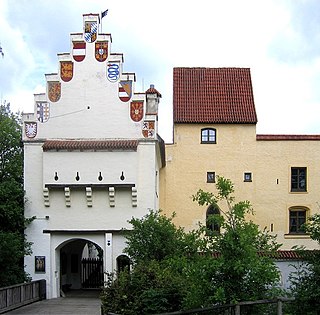
Grünwald Castle is a medieval hill castle in Grünwald, Bavaria.

The Moszna Castle is a historic castle and palace located in the small village of Moszna, in southwestern Poland. Situated approximately 30 kilometres (19 mi) south of the regional capital Opole, between the towns of Prudnik and Krapkowice, the residence is an excellent example of romantic fairy-tale and eclectic architecture.
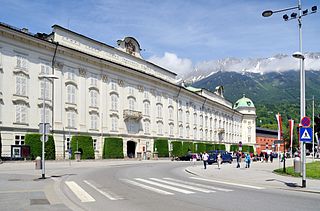
The Hofburg is a former Habsburg palace in Innsbruck, Austria, and considered one of the three most significant cultural buildings in the country, along with the Hofburg Palace and Schönbrunn Palace in Vienna. The Hofburg is the main building of a large residential complex once used by the Habsburgs that still includes the Noblewomen's Collegiate Foundation, the Silver Chapel, the Hofkirche containing Emperor Maximilian's cenotaph and the Schwarzen Mandern, the Theological University, the Tyrolean Folk Art Museum, Innsbruck Cathedral, the Congress, and the Hofgarten.

Schloss Weinzierl is a castle in Weinzierl, near Wieselburg/Erlauf in the southwestern Mostviertel region of Lower Austria, located in a park. The essential components of the existing building date to the early 18th century' on earlier foundations. The four-winged castle encloses a courtyard including arcades and corner towers in late-baroque style. The complex also includes an original early Baroque church with post-gothic elements.

The Cour Carrée is one of the main courtyards of the Louvre Palace in Paris. The wings surrounding it were built gradually, as the walls of the medieval Louvre were progressively demolished in favour of a Renaissance palace.




























